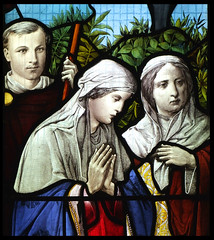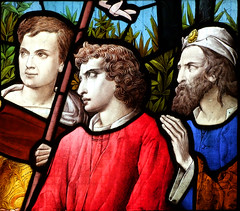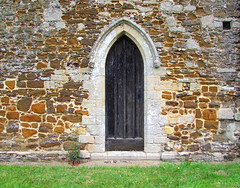| |
|
St Mary
Magdalene, Pentney
 |
|
Pentney
seemed a lovely village. I'd been dodging the
traffic on the A47, and it seemed such a relief
to turn off at West Bilney and cycle down the
long, quiet lane which leads to Pentney church.
The tower was like a beacon ahead, and when I
came to it I was struck by the neatness of the
churchyard, and the long tunnel-like appearance
of the nave and chancel. It was as if everything
had been drawn with a ruler. As you'd expect in
this part of Norfolk, the church is constructed
largely from a mixture of carstone and river bed
rubble, the tower mostly from flint. The coursing
under the roofline gives the effect of some kind
of speciality cake, as if you could take a knife
and cut a delicious slice. You look at
the church and you think to yourself, well,
they're 13th Century windows in the bell tower
and that's a 13th Century chancel. Someone in the
early 16th Century has put Perpendicular windows
in the nave, but ignoring that this is of course
a 13th Century church. And then you step inside
and realise that you couldn't be more wrong,
because to north and south of the nave are
beautiful interlaced arcades of the Norman
period.
And
this is where it gets even more interesting,
because as Mortlock points out, the part of the
church with this arcading must have been the
chancel originally. So what we actually have is a
small church, a tiny church, of the
Norman period. And then something happened at
Pentney and a tower was slapped on, the nave and
chancel were converted into one long nave, and a
new chancel was added.
|
Why did
they need to make Pentney church bigger? The Augustinian
priory here had been established before the middle of the
12th Century, but there, too, there were substantial
building projects in the 13th and 14th Centuries. One can
only imagine that Pentney simply kept getting bigger,
more prosperous, and more important. Hard to imagine
today. If anyone could tell us, it is the bewhiskered
fellow forming a corbel head on the north wall, but he
keeps his counsel.
I am often
critical of the work of the Ward & Hughes workshop on
this website. The busiest workshop in the land by the end
of the 19th Century, their policy seems to have been to
fill churches with thick-glassed sentimental scenes of
variable quality, and after the turn of the century the
drawing is often execrable.
| But
Pentney is in the fortunate position of having
commissioned Ward & Hughes fairly early on in
their careers. In 1886, the Thackeray family paid
for the east window to be installed, a
crucifixion scene which is at first sight
attractive and interesting, three figures either
side of the crucified Christ and Mary Magdalene
at his feet, all under a floral canopy. But it
bears even closer inspection. To the right of
Christ are the figures of Longinus, John and
Peter, with none of the jazzy halos that would
soon become Ward & Hughes's hallmark, but
characterful faces not bereft of emotion. Mary
Magdalene is struck down by grief, but it is the
three figures on the left hand side that demand
our attention. The two Marys are sombre and
sorrowful, but behind them is a third figure who
looks like a wanderer, a traveller who has turned
up at the last minute to find out what is going
on. In fact, it is a portrait of Charles Carnegie
Thackeray, a lieutenant in the Cheshire Regiment,
who in 1884 at the age of 25 died in Solon, the
modern Solo in Indonesia. Quite what the Cheshire
Regiment were doing in a Dutch Colony in 1884 I
don't know, but here Charles is, and the two
Marys are portraits of his sister and his mother.
A haunting piece of social history, quite up
there with the interlaced arcades and the
bewhiskered fellow on the corbel.
|
|
 |
|
|
|

